Primate tourism: A well-organised industry
Uganda's primates—including the giant gorillas—remind us of our evolutionary past, and their precarious future


A chimpanzee at the Kibale National Park in Uganda
Image: Barcroft Media / Getty Images
Primates, especially the great apes, are the ultimate in charismatic mega-fauna and that includes all the fabled predators. Perhaps, it is the evolutionary link. In the 19th century, Charles Darwin correctly surmised the relationship between African apes and humans, a connection that the recent DNA sequencing of gorilla, chimpanzee and bonobo genomes has confirmed.
In the last 30 years, primate tourism—lemurs in Madagascar, snow monkeys in Japan, and orangutans in Malaysia and Indonesia—has gained in popularity. But trekking to see gorillas in the wild remains, by some margin, the most sought-after experience.
The economic value and concerns for maintaining the ‘resource’—one mountain gorilla can generate $3-5 million in tourism revenue over its lifetime—have meant that the enterprise has evolved into a well-organised industry. Rwanda and Uganda charge up to $1,500 or $600, respectively, per person for one hour with the mountain gorillas. 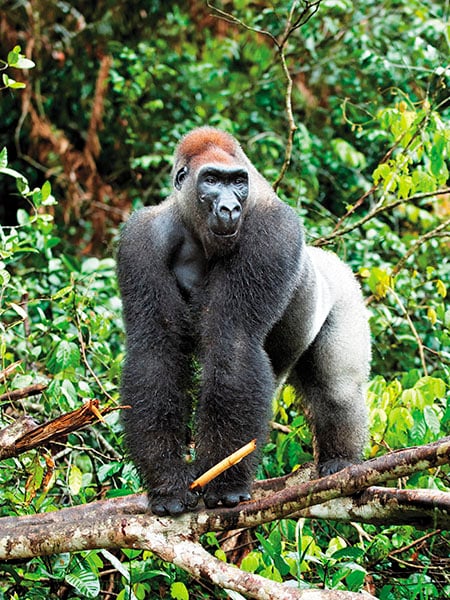 Each gorilla family group is usually led by a fully developed adult silverback male gorilla, which can be 2 m tall and weigh around 250 kg
Each gorilla family group is usually led by a fully developed adult silverback male gorilla, which can be 2 m tall and weigh around 250 kg
Image: Sergey Uryadnikov / Shutterstock The experience is regimented: You attend a briefing and are checked for any communicable disease that can result in summary exclusion from the trek with no refund. You are allocated a guide and porters who, for a fee, will carry your backpacks. Armed guards accompany you to protect the mainly Western tourists from the wrong kind of ‘guerrillas’, who have a habit of taking hostages for ransom.
The gorilla groups you visit are habituated to humans each group is visited daily to ensure they remain accustomed. Eight people are allowed to spend one hour with the gorillas. With trackers monitoring the groups closely, a sighting is almost guaranteed.
It wasn’t always so. A Zimbabwean friend recalled a trip to Rwanda in the 1970s during which he was visiting friends. One weekend, as they were near the national park, they decided to try and catch a glimpse of the gorillas. Finding a guide, they set off, and after half a day or so, they came upon signs—gorilla excrement and broken bamboo saplings. The guide looked cursorily at these markers. The gorillas had been there a long time ago, and it was now too late to get to them and return before dark. The group turned back. My friend did see the gorillas on a later trip, although they all disappeared quickly into the forest.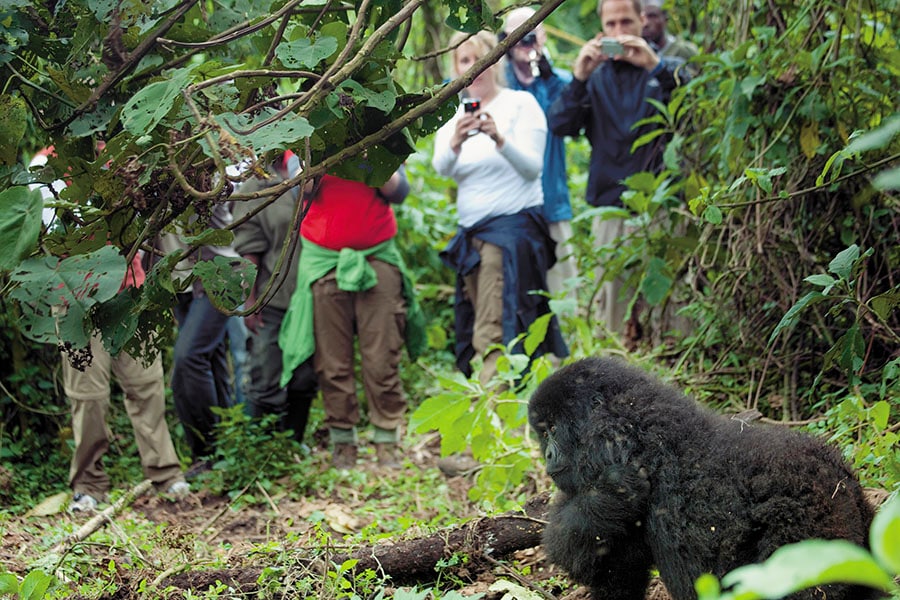 Tourists watch a gorilla at a national park in Rwanda
Tourists watch a gorilla at a national park in Rwanda
Image: Eric Lafforgue / Getty Images
Attenborough Moments
We too had travelled to see the mountain gorillas in what must seem like pre-industrial times in 1991. We went to the Kahuzi-Biega Park in Congo (then known as Zaire), now rarely visited because of security concerns. The itinerary had said something similar to: ‘After an early breakfast, depart for your day of tracking gorillas in the park with picnic lunch.’
The description was not exact. Depending upon where the gorillas were, we learnt that it can take several hours of sometimes difficult walking. The Virunga mountains are steep and muddy. The combination of undergrowth and dense vegetation makes it difficult to walk. The name—Bwindi Impenetrable Forest—provides a more reasonable indication about what to expect.
We had booked two treks to make sure we saw the gorillas. Each day, the trackers started near where the gorillas were seen the previous day, beginning from their night beds (crude platforms made from twigs and leaves in trees) and followed a trail of broken bamboo saplings (a favourite gorilla food) and faeces, whose temperature allows accurate estimates of the time of their presence.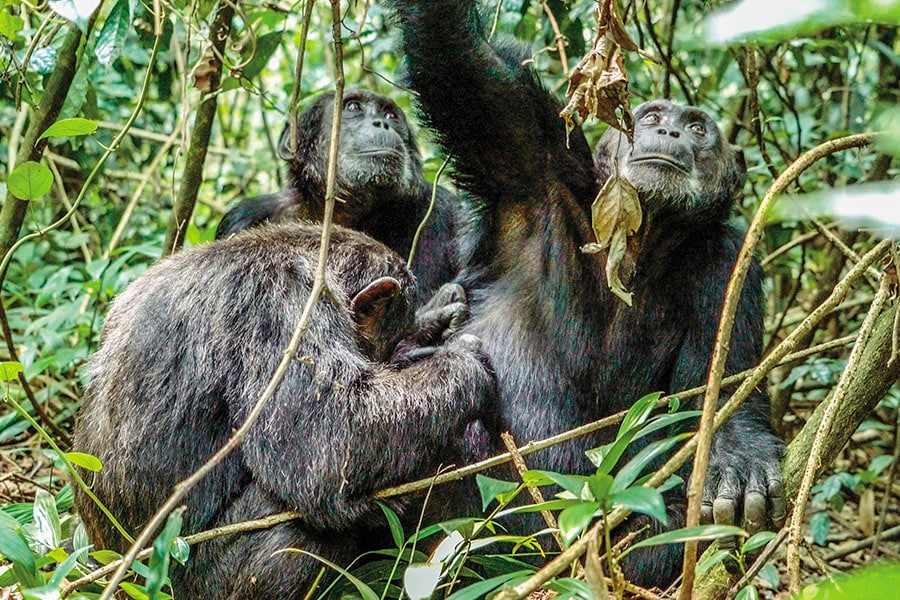 Gorillas grooming each other
Gorillas grooming each other
Image: Steven Fish / Shutterstock
The rules are simple. When you are near the gorillas, you must maintain your distance. You must adopt a submissive pose. Eye contact is forbidden. You must be quiet. If a gorilla charges, then you must not run, but hold your ground.
We saw two separate gorilla families. Each group consisted of several females, their young and older juveniles. Each family was headed by a silverback (the term comes from the white hair on the back of the adult male). A fully developed adult male is around 250 kg and 2 metres tall. Up close, a silverback is electrifying.
The first family group we saw was headed by a silverback called Mahesi, a gorilla featured on the currency of Zaire. They were feeding. They would stop to eat some bamboo or other shoots then, they continued foraging. We kept moving with them. A young gorilla decided to give us a demonstration of his strength and abilities. He clambered up a sapling, until he was directly above our heads. The tree swayed under his weight. He released his hands to pound on his chest. Gorillas pound on their chests, producing a soft drumming sound, as a signal or other communication.
Releasing his grip to pound his chest unbalanced him and he tumbled down, ending up on the ground almost on top of us. We were worried whether the mother or silverback would react. But the other gorillas took no notice at all. A L’Hoest’s monkey, sometimes called the owl-faced monkey
A L’Hoest’s monkey, sometimes called the owl-faced monkey
Image: Shutterstock
On the second day, we visited a different family grouping. The silverback was known as Musamuka. The gorillas were resting after a feed. They were grooming each other, while the young were playing. The group had two young males who would soon leave to start families of their own. One reclined on his back in a hollow, resting less than 2 metres from us. He propped himself on one arm in an approximation of Auguste Rodin’s ‘The Thinker’, and looked directly at us. It was impossible to avoid his open and inquiring gaze. We looked back at him and our eyes locked for a few seconds, both sides ignoring the rules against eye contact.
For every individual fortunate enough to make this journey, the emotion of the encounter is real. Given the highly managed encounter, the magic is testament to the power of these wonderful, gentle creatures.
Other Relatives
A quarter of a century later, in 2015, our focus is on Uganda’s other primates. We see cheeky and curious vervet monkeys and the related samango or blue monkeys. There are the poorly studied, round faced, red-tailed L’Hoest’s monkeys, sometimes called owl-faced monkeys. We find grey-cheeked mangabeys, whose rufous or golden mane around the neck sets off their dark brown fur. Large families of olive baboons are common throughout Uganda. We see patas monkeys, whose long legs and slender bodies are well adapted to their terrestrial existence in the dry savannah. The patas males are a reddish colour with a garish bright blue scrotum. We see red and black-and-white colobus monkeys. The latter, also known as Guerza, are extraordinarily beautiful with a V-shaped mantle of white hair extending down the sides and along the back, sharply contrasting their black fur. Their faces are circled by a distinctive pattern of short white hair.
But the star attraction are the chimpanzees. We visit the tropical forests of Kibale National Park, where around 1,500 live. There are three habituated groups, two of which tourists can visit while the other is reserved for researchers. There are two options: A one-hour tracking experience like the gorillas or a full-day chimpanzee habituation experience that allows you to spend an entire day with them. We try each alternative on successive days.
We start early, at 6 am. In theory, there is a group of eight (for the one-hour tracking option) and four (for the habituation option). However, on both days, we are by ourselves. Our guides, Gerrard and Silver, are both veterans with more than two decades of experience working with the chimpanzees. They carry a Russian AK-47 rifle, primarily to scare off elephants and buffalo. The objective is to get to the group, which has about 150 members, as it begins the day and starts to forage. On both days, the group is well into its daily routine by the time we catch up with it, after an hour or so of tracking. 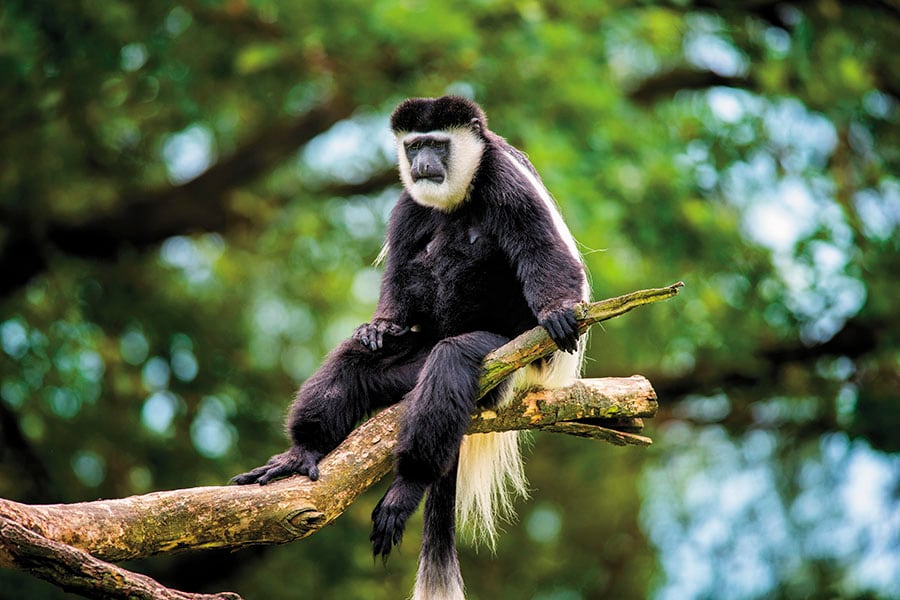 Some colobus monkeys have a V-shaped mantle of white hair extending down their sides and backs, contrasting with their black fur
Some colobus monkeys have a V-shaped mantle of white hair extending down their sides and backs, contrasting with their black fur
Image: Nick Fox / Shutterstock
We hear the chimpanzees well before we see them, with their loud and far-reaching pant-hoots echoing eerily through the forest. It starts with breathy, low-pitched hoots that get quicker and more high-pitched, building to a loud climax. Not fully understood, the vocalisations may perform various functions: Contact calls or greetings between group members, allowing identification as well as expressing anger or excitement.
When we reach them, they are high in the canopy, feeding in fruiting trees. We crane our necks, trying to get good views of around 40 to 50 chimpanzees feasting on figs. We watch and wait for them to come down, being careful to avoid the falling fruit as well as the occasional golden shower of urine or something more substantial. After two hours, they suddenly bound down from the trees with astonishing rapidity. We find ourselves surrounded by them—males, females and babies.
On the ground, their human-like appearance is evident. The adults are around 1.2 metres tall, weighing around 30 to 40 kg. Their arms are longer than their legs, about one and a half times their height they have no tails. The black or brown hair covering their bodies is sparse. The face, fingers, palms of the hands and soles of the feet are a hairless pink or brown. With the help of Gerrard and Silver, who know each chimpanzee well, we begin to see the differences between each one of them.
Passing within a few feet of us, they scatter into the forest, moving purposefully with great agility and speed through dense vegetation. We follow as best we can, struggling to keep up with their unpredictable movements.
On both days, we get the opportunity to see a whole spectrum of their natural behaviours. We watch mothers carrying and feeding their tiny pink offspring young chimpanzees swinging clumsily through the trees an older chimpanzee, once a high-ranking member of the group, foraging on special abrasive leaves in a particular tree to help with digestion and parasites. Individual personalities are on show cheeky young males, coy nubile females, older matrons, dominant males, pretenders plotting leadership.
The highly organised social structure is evident in the interactions between different members of the troop, with obvious deference being paid to dominant members. We watch two males in the ruling clique grooming each other and sharing a jackfruit, using the interaction to strengthen their relationship. Older individuals keep to the edges of the main group. In chimp society, deposed older males do not leave but live peacefully within the group under the suzerainty of the new leader.
One moment stays with us. We were on a path when I looked back and saw four chimpanzees just behind us. The guide asked us to stand to the side to let them pass. This is the alpha male, the current leader, accompanied by his leadership group. He moved past us, knuckle-walking on all fours, the clenched fists supporting them. They were so close, I could almost reach out and touch them. My nostrils were full of their musky, forest odour. The leader moved confidently and disappeared down the trail, without once looking at us. Sensing something, I looked up and saw two black and white colobus monkeys watching the chimpanzees very quietly. Their fear was palpable. The chimpanzees have a taste for meat, and are savage hunters who prey on the much smaller colobus monkeys. It is a reminder of the duality of our closest ape relatives.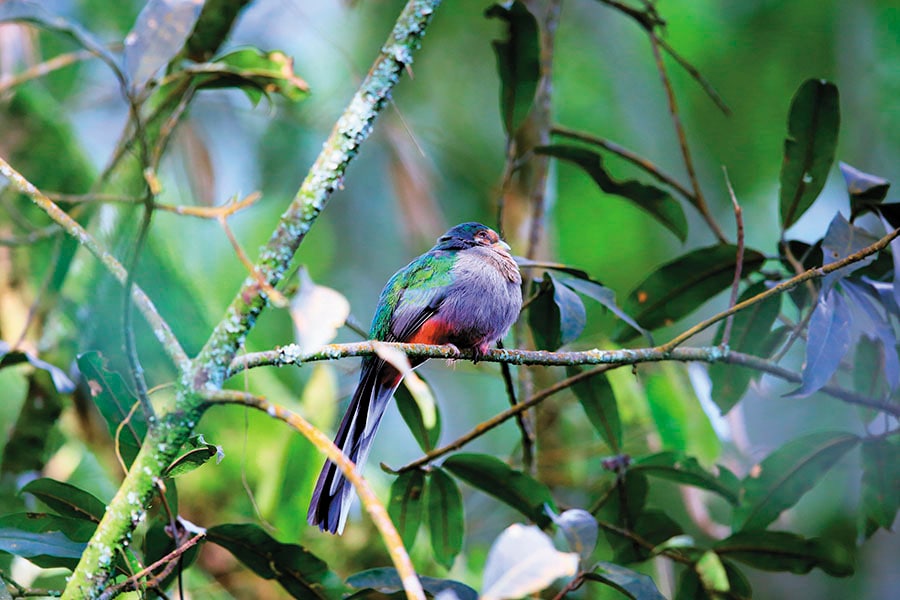 Narina trogon is a bird native to the African tropics and found in the jungles of Uganda and Rwanda
Narina trogon is a bird native to the African tropics and found in the jungles of Uganda and Rwanda
Image: Feathercollector / Shutterstock
Unexpected Encounters
Despite our plan to visit Bwindi, we have decided not to trek to the gorillas, preferring, unlike Jay Gatsby, not to try to recapture the past.
At Buhoma, we walk a trail searching for birds—Narina trogon, which we find, and Fraser’s eagle-owls, which we don’t. As the trail is close to the territory of one of the habituated gorilla groups, we come across the returning trekkers, flushed with the excitement and elation of a successful gorilla tracking exercise. We overhear conversations about the size of the silverback male, and the curious babies. It brings back memories of the two hours we had spent with the mountain gorillas, which remain intensely special to us.
Early afternoon, with rain threatening to hamper our progress, we turn back. Along the road, we hear the distinctive staccato grunts of a gorilla nearby. And then, without warning, a few metres in front of us on the trail, three gorillas emerge from the forest, surprised to see us. The huge silverback is a few feet from me. The family group is crossing the trail to forage in the western edge of the park.
The rangers are concerned that the gorillas may cross the nearby border into Congo, where poaching is prevalent. So, we must stay with the family while the head ranger, Tito, is summoned. He will coax the group back to the safety of Uganda. While we wait, we see eight members of the family on or near the road. It is an unexpected delight. Once Tito arrives on a motor bike, we resume our walk back to the village. I turn back to look at the majestic creatures. I will never have the chance to see them again.
Last Of Their Kind
Today, there are around 700 to 800 mountain gorillas left in the wild, and just 200,000 chimpanzees in Africa. Numbers of both have fallen by almost 80 percent in the last 20 years. They are severely threatened by the trade in bushmeat, loss of habitat from agriculture, logging and mining, hunting for body parts and the pet trade, conflict and wars around the Great Lakes and diseases including those acquired from humans, such as tourists.
In 2003, the Wildlife Photographer of the Year award was given to Germany’s Gerhard Schulz for a photo of a gorilla and a child taken in Miami’s Metro zoo. The gorilla is seated in his enclosure behind glass. The child, a visitor to the zoo, is reflected in the glass. The child admires the primate so closely related to him in the chain of evolution. The gorilla is contemplative. There is a sadness and resignation in his expression. He is a prisoner far from his African home. His species, once abundant, is near extinction. There is no place in this world for him and his kind. The only existence that humans can afford this magnificent giant, no less a creation than man, is that of an object of curiosity and display in a zoo.
First Published: Dec 03, 2017, 06:01
Subscribe Now